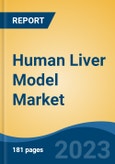Free Webex Call
The Human Liver Model Market was valued at USD 615.95 Million in 2024, and is expected to reach USD 786.63 Million by 2030, rising at a CAGR of 4.12%. The Global Human Liver Model Market is expanding rapidly, driven by breakthroughs in bioengineering, rising liver disease prevalence, and the growing need for more precise drug testing platforms. As metabolic disorders, viral hepatitis, and alcohol-related liver conditions continue to surge, pharmaceutical and biotechnology companies are making significant investments in advanced liver models to enhance drug discovery, toxicity screening, and regenerative medicine research. Speak directly to the analyst to clarify any post sales queries you may have.
10% Free customizationThis report comes with 10% free customization, enabling you to add data that meets your specific business needs.
The increasing incidence of liver cancer, coupled with high mortality rates, underscores the urgent need for more effective and predictive research models. Additionally, the shortage of donor organs for liver transplants has accelerated the development of bioengineered liver tissues and alternative therapeutic solutions, driving further innovation in the field.
Key Market Drivers
Pharmaceutical Research Advancements
The Global Human Liver Model Market is experiencing a transformative surge in demand, driven in large part by the rapid advancements in pharmaceutical research. As the pharmaceutical industry faces increasing pressure to develop safer and more effective drugs while reducing time and costs, human liver models have emerged as indispensable tools.Pharmaceutical companies are continually searching for more efficient and accurate ways to evaluate drug candidates. Human liver models provide a realistic and dynamic environment to test potential drugs, predict their pharmacokinetics, and assess their toxicity. This level of precision significantly reduces the risk of late-stage clinical trial failures, leading to substantial cost savings and a more streamlined drug development process.
Key Market Challenges
Complexity of Liver Functionality
The liver is an incredibly complex organ with numerous functions, including detoxification, metabolism, and protein synthesis. Replicating all of its functions accurately in a model is challenging. Researchers are working on improving the physiological relevance of liver models, but achieving a complete emulation remains a formidable task.Key Market Trends
Multi-Organ-on-a-Chip Systems
The development of multi-organ-on-a-chip systems is a groundbreaking trend. These platforms enable the study of interactions between the liver and other organs, providing a more comprehensive understanding of how drugs and diseases affect the entire human body. Such models hold immense promise for advancing drug development and personalized medicine.Key Market Players
- Organovo Holdings Inc
- BioIVT LLC
- InSphero AG
- Emulate Inc
- Mimetas BV
- CN Bio
- Cyfuse Biomedical KK
- Hurel Corp
Report Scope:
In this report, the Global Human Liver Model Market has been segmented into the following categories, in addition to the industry trends which have also been detailed below:Human Liver Model Market, By Product:
- 2D Models
- 3D Bio Printing
- Liver Organoids
Human Liver Model Market, By Application:
- Drug Discovery
- Academics & Research
Human Liver Model Market, By Region:
- North America
- United States
- Canada
- Mexico
- Europe
- Germany
- United Kingdom
- France
- Italy
- Spain
- Asia-Pacific
- China
- Japan
- India
- Australia
- South Korea
- South America
- Brazil
- Argentina
- Colombia
- Middle East & Africa
- South Africa
- Saudi Arabia
- UAE
- Kuwait
Competitive Landscape
Company Profiles: Detailed analysis of the major companies present in the Global Human Liver Model Market.Available Customizations:
With the given market data, the publisher offers customizations according to a company's specific needs. The following customization options are available for the report.Company Information
- Detailed analysis and profiling of additional market players (up to five).
This product will be delivered within 1-3 business days.
Table of Contents
1. Product Overview
2. Research Methodology
3. Executive Summary
5. Global Human Liver Model Market Outlook
6. North America Human Liver Model Market Outlook
7. Europe Human Liver Model Market Outlook
8. Asia-Pacific Human Liver Model Market Outlook
9. South America Human Liver Model Market Outlook
10. Middle East and Africa Human Liver Model Market Outlook
11. Market Dynamics
12. Market Trends & Developments
13. Porter’s Five Forces Analysis
14. Competitive Landscape
Companies Mentioned
- Organovo Holdings Inc
- BioIVT LLC
- InSphero AG
- Emulate Inc
- Mimetas BV
- CN Bio
- Cyfuse Biomedical KK
- Hurel Corp
Table Information
| Report Attribute | Details |
|---|---|
| No. of Pages | 185 |
| Published | March 2025 |
| Forecast Period | 2024 - 2030 |
| Estimated Market Value ( USD | $ 615.95 Million |
| Forecasted Market Value ( USD | $ 786.63 Million |
| Compound Annual Growth Rate | 4.1% |
| Regions Covered | Global |
| No. of Companies Mentioned | 8 |









